The Potential Role of Iceland in Northern Europe’s Protein Self-Sufficiency: Feasibility Study of Large-Scale Production of Spirulina in a Novel Energy-Food System
Abstract
1. Introduction
2. Methods and Materials
2.1. System Boundaries
2.2. Model Design
2.3. Spirulina Biomass Production Unit (PU)
2.4. Iceland’s Renewable Energy Resources and Electricity Generation
2.5. Spirulina Biomass Production Scale-Up Scenarios
2.5.1. Scenario 1: Conservative Scale-Up
2.5.2. Scenario 2: Moderate Scale-Up
2.5.3. Scenario 3: Fundamental Scale-Up
2.5.4. Scenario 4: Visionary Scale-Up
2.5.5. Scenario 5: Transformational Scale-Up
2.5.6. Scenario 6: Ultimate Scale-Up
2.6. Protein Requirements and Demand
3. Results
3.1. Protein Self-Sufficiency Prospects
3.1.1. Scenario 1: Conservative Scale-Up
3.1.2. Scenario 2: Moderate Scale-Up
3.1.3. Scenario 3: Fundamental Scale-Up
3.1.4. Scenario 4: Visionary Scale-Up
3.1.5. Scenario 5: Transformational Scale-Up
3.1.6. Scenario 6: Ultimate Scale-Up
3.2. Global GHG Reduction Potential If Climate Change Mitigation Is Prioritized over Protein Self-Sufficiency
4. Discussion
4.1. Reflection on Key Findings
4.2. Reservations
5. Conclusions
Supplementary Materials
Author Contributions
Funding
Data Availability Statement
Acknowledgments
Conflicts of Interest
References
- FAO; WHO. Protein and Amino Acid Requirements in Human Nutrition: Report of a Joint FAO/WHO/UNU Expert Consultation; World Health Organization: Geneva, Switzerland, 2007. [Google Scholar]
- Gilbert, J.A.; Bendsen, N.T.; Tremblay, A.; Astrup, A. Effect of proteins from different sources on body composition. Nutr. Metab. Cardiovasc. Dis. 2011, 21, B16–B31. [Google Scholar] [CrossRef] [PubMed]
- Statovci, D.; Aguilera, M.; MacSharry, J.; Melgar, S. The impact of western diet and nutrients on the microbiota and immuneresponse at mucosal interfaces. Front. Immunol. 2017, 8, 838. [Google Scholar] [CrossRef] [PubMed]
- Hoffman, J.R.; Falvo, M.J. Protein–which is best? J. Sport. Sci. Med. 2004, 3, 118. [Google Scholar]
- Steinfeld, H.; Gerber, P.; Wassenaar, T.D.; Castel, V.; Rosales, M.; Rosales, M.; de Haan, C. Livestock’s Long Shadow: Environmental Issues and Options; Food & Agriculture Organization: Québec City, QC, Canada, 2006. [Google Scholar]
- Henchion, M.; Hayes, M.; Mullen, A.M.; Fenelon, M.; Tiwari, B. Future protein supply and demand: Strategies and factors influencing a sustainable equilibrium. Foods 2017, 6, 53. [Google Scholar] [CrossRef]
- Godfray, H.C.J.; Aveyard, P.; Garnett, T.; Hall, J.W.; Key, T.J.; Lorimer, J.; Jebb, S.A. Meat consumption, health, and the environment. Science 2018, 361, eaam5324. [Google Scholar] [CrossRef]
- Poore, J.; Nemecek, T. Reducing food’s environmental impacts through producers and consumers. Science 2018, 360, 987–992. [Google Scholar] [CrossRef]
- de Boer, J.; Schösler, H.; Aiking, H. Fish as an alternative protein–A consumer-oriented perspective on its role in a transition towards more healthy and sustainable diets. Appetite 2020, 152, 104721. [Google Scholar] [CrossRef]
- Arvanitoyannis, I.S.; Kassaveti, A. Fish industry waste: Treatments, environmental impacts, current and potential uses. Int. J. Food Sci. Technol. 2008, 43, 726–745. [Google Scholar] [CrossRef]
- Symes, D.; Phillipson, J.; Salmi, P. Europe’s Coastal Fisheries: Instability and the Impacts of Fisheries Policy. Sociol. Rural. 2015, 55, 245–257. [Google Scholar] [CrossRef]
- Dayton, P.K.; Thrush, S.F.; Agardy, M.T.; Hofman, R.J. Environmental effects of marine fishing. Aquat. Conserv. Mar. Freshw. Ecosyst. 1995, 5, 205–232. [Google Scholar] [CrossRef]
- Scarborough, P.; Appleby, P.N.; Mizdrak, A.; Briggs, A.D.; Travis, R.C.; Bradbury, K.E.; Key, T.J. Dietary greenhouse gas emissions of meat-eaters, fish-eaters, vegetarians and vegans in the UK. Clim. Chang. 2014, 125, 179–192. [Google Scholar] [CrossRef] [PubMed]
- Springmann, M.; Clark, M.; Mason-D’Croz, D.; Wiebe, K.; Bodirsky, B.L.; Lassaletta, L.; Willett, W. Options for keeping the food system within environmental limits. Nature 2018, 562, 519–525. [Google Scholar] [CrossRef] [PubMed]
- Willett, W.; Rockström, J.; Loken, B.; Springmann, M.; Lang, T.; Vermeulen, S.; Murray, C.J. Food in the Anthropocene: The EAT—Lancet Commission on healthy diets from sustainable food systems. Lancet 2019, 393, 447–492. [Google Scholar] [CrossRef] [PubMed]
- Muller, A.; Schader, C.; El-Hage Scialabba, N.; Brüggemann, J.; Isensee, A.; Erb, K.H.; Niggli, U. Strategies for feeding the world more sustainably with organic agriculture. Nat. Commun. 2017, 8, 1290. [Google Scholar] [CrossRef] [PubMed]
- Eyhorn, F.; Muller, A.; Reganold, J.P.; Frison, E.; Herren, H.R.; Luttikholt, L.; Smith, P. Sustainability in global agriculture driven by organic farming. Nat. Sustain. 2019, 2, 253–255. [Google Scholar] [CrossRef]
- LaCanne, C.E.; Lundgren, J.G. Regenerative agriculture: Merging farming and natural resource conservation profitably. PeerJ 2018, 6, e4428. [Google Scholar] [CrossRef]
- Schulte, L.A.; Dale, B.E.; Bozzetto, S.; Liebman, M.; Souza, G.M.; Haddad, N.; Arbuckle, J.G. Meeting global challenges with regenerative agriculture producing food and energy. Nat. Sustain. 2022, 5, 384–388. [Google Scholar] [CrossRef]
- Njakou Djomo, S.; Knudsen, M.T.; Martinsen, L.; Andersen, M.S.; Ambye-Jensen, M.; Møller, H.B.; Hermansen, J.E. Green proteins: An energy-efficient solution for increased self-sufficiency in protein in Europe. Biofuels Bioprod. Biorefining 2020, 14, 605–619. [Google Scholar] [CrossRef]
- Guilpart, N.; Iizumi, T.; Makowski, D. Data-driven projections suggest large opportunities to improve Europe’s soybean self-sufficiency under climate change. Nat. Food 2022, 3, 255–265. [Google Scholar] [CrossRef]
- Lucas, M.M.; Stoddard, F.L.; Annicchiarico, P.; Frías, J.; Martinez-Villaluenga, C.; Sussmann, D.; Pueyo, J.J. The future of lupin as a protein crop in Europe. Front. Plant Sci. 2015, 6, 705. [Google Scholar] [CrossRef]
- Kummu, M.; Kinnunen, P.; Lehikoinen, E.; Porkka, M.; Queiroz, C.; Röös, E.; Weil, C. Interplay of trade and food system resilience: Gains on supply diversity over time at the cost of trade independency. Glob. Food Secur. 2020, 24, 100360. [Google Scholar] [CrossRef]
- Jouan, J.; Ridier, A.; Carof, M. Legume production and use in feed: Analysis of levers to improve protein self-sufficiency from foresight scenarios. J. Clean. Prod. 2020, 274, 123085. [Google Scholar] [CrossRef]
- European Commission Conference Report. The Development of Plant Proteins in the European Union. Agriculture and Rural Development, European Union. 2018. Available online: https://agriculture.ec.europa.eu/events/development-plant-proteins-european-union-opportunities-and-challenges-2018-11-22_en (accessed on 8 September 2022).
- U.S. Department of Agriculture. GAIN Report E18070, European Union Unveils Its Protein Plan; USDA Foreign Agricultural Service: Washington, DC, USA, 2018.
- de Visser, C.; Schreuder, R.; Stoddard, F. The EU’s Dependence on Soya Bean Import for the Animal Feed Industry and Potential for EU Produced Alternatives. Oilseeds Fats Crops Lipids 2014, 21, D407. [Google Scholar] [CrossRef]
- Bailey, R.; Wellesley, L. Chokepoints and Vulnerabilities in Global Food Trade; Chatham House: London, UK, 2017; p. 111. [Google Scholar]
- Benton, T.G.; Froggatt, A.; Wellesley, L.; Schröder, P. The Ukraine War and Threats to Food and Energy Security; Chatham House: London, UK, 2022. [Google Scholar]
- Rzymski, P.; Kulus, M.; Jankowski, M.; Dompe, C.; Bryl, R.; Petitte, J.N.; Mozdziak, P. COVID-19 pandemic is a call to search for alternative protein sources as food and feed: A review of possibilities. Nutrients 2021, 13, 150. [Google Scholar] [CrossRef] [PubMed]
- Savary, S.; Akter, S.; Almekinders, C.; Harris, J.; Korsten, L.; Rötter, R.; Watson, D. Mapping disruption and resilience mechanisms in food systems. Food Secur. 2020, 12, 695–717. [Google Scholar] [CrossRef] [PubMed]
- Tzachor, A.; Richards, C.E.; Holt, L. Future foods for risk-resilient diets. Nat. Food 2021, 2, 326–329. [Google Scholar] [CrossRef]
- Davis, K.F.; Downs, S.; Gephart, J.A. Towards food supply chain resilience to environmental shocks. Nat. Food 2021, 2, 54–65. [Google Scholar] [CrossRef]
- Richards, C.E.; Lupton, R.C.; Allwood, J.M. Re-framing the threat of global warming: An empirical causal loop diagram of climate change, food insecurity and societal collapse. Clim. Chang. 2021, 164, 1–19. [Google Scholar] [CrossRef]
- European Commission. Report from the Commission to the Council and the European Parliament on the Development of Plant Proteins in the European Union. European Union. Available online: https://eur-lex.europa.eu/legal-content/EN/TXT/?uri=CELEX%3A52018DC0757 (accessed on 8 September 2022).
- Santamaría-Fernández, M.; Lübeck, M. Production of leaf protein concentrates in green biorefineries as alternative feed for monogastric animals. Anim. Feed. Sci. Technol. 2020, 268, 114605. [Google Scholar] [CrossRef]
- Balázs, B.; Kelemen, E.; Centofanti, T.; Vasconcelos, M.W.; Iannetta, P.P. Integrated policy analysis to identify transformation paths to more sustainable legume-based food and feed value-chains in Europe. Agroecol. Sustain. Food Syst. 2021, 45, 931–953. [Google Scholar] [CrossRef]
- Hann, E.C.; Overa, S.; Harland-Dunaway, M.; Narvaez, A.F.; Le, D.N.; Orozco-Cárdenas, M.L.; Jinkerson, R.E. A hybrid inorganic–biological artificial photosynthesis system for energy-efficient food production. Nat. Food 2022, 3, 461–471. [Google Scholar] [CrossRef]
- World Economic Forum. Meat: The Future Series: Alternative Proteins. Cologny/Geneva, Switzerland; World Economic Forum: Colony, Switzerland, 2019. [Google Scholar]
- Bleakley, S.; Hayes, M. Algal proteins: Extraction, application, and challenges concerning production. Foods 2017, 6, 33. [Google Scholar] [CrossRef] [PubMed]
- Humpenöder, F.; Bodirsky, B.L.; Weindl, I.; Lotze-Campen, H.; Linder, T.; Popp, A. Projected environmental benefits of replacing beef with microbial protein. Nature 2022, 605, 90–96. [Google Scholar] [CrossRef] [PubMed]
- Villaró, S.; Morillas-España, A.; Acién, G.; Lafarga, T. Optimisation of Operational Conditions during the Production of Arthrospira platensis Using Pilot-Scale Raceway Reactors, Protein Extraction, and Assessment of their Techno-Functional Properties. Foods 2022, 11, 2341. [Google Scholar] [CrossRef] [PubMed]
- Parodi, A.; Leip, A.; De Boer, I.J.M.; Slegers, P.M.; Ziegler, F.; Temme, E.H.; Van Zanten, H.H.E. The potential of future foods for sustainable and healthy diets. Nat. Sustain. 2018, 12, 782–789. [Google Scholar] [CrossRef]
- Ramírez-Rodrigues, M.M.; Estrada-Beristain, C.; Metri-Ojeda, J.; Pérez-Alva, A.; Baigts-Allende, D.K. Spirulina platensis protein as sustainable ingredient for nutritional food products development. Sustainability 2021, 13, 6849. [Google Scholar] [CrossRef]
- Sturludóttir, E.; Thorvaldsson, G.; Helgadottir, G.; Gudnason, I.; Sveinbjornsson, J.; Sigurgeirsson, O.I.; Sveinsson, T. Fæðuöryggu á Íslandi. Skýrsla unnin fyrir atvinnuvega-og nýsköpunarráðuneytið (Food security in Iceland. Report prepared for the Ministry of Industry and Innovation). Rit LbhÍ 2021, 139, 56. [Google Scholar]
- Jóhannsson, O. Food Security in Iceland: Present Vulnerabilities, Possible Solutions. Master’s Dissertation, University of Iceland, Reykjavik, Iceland, 2011. [Google Scholar]
- Shafiei, E.; Davidsdottir, B.; Leaver, J.; Stefansson, H.; Asgeirsson, E.I. Potential impact of transition to a low-carbon transport system in Iceland. Energy Policy 2014, 69, 127–142. [Google Scholar] [CrossRef]
- Barber, J.; Tran, P.D. From natural to artificial photosynthesis. J. R. Soc. Interface 2013, 10, 20120984. [Google Scholar] [CrossRef]
- Dogutan, D.K.; Nocera, D.G. Artificial photosynthesis at efficiencies greatly exceeding that of natural photosynthesis. Acc. Chem. Res. 2019, 52, 3143–3148. [Google Scholar] [CrossRef]
- Zhang, Y.H.P. Next generation biorefineries will solve the food, biofuels, and environmental trilemma in the energy–food–water nexus. Energy Sci. Eng. 2013, 1, 27–41. [Google Scholar] [CrossRef]
- Yu, J. Bio-based products from solar energy and carbon dioxide. Trends Biotechnol. 2014, 32, 5–10. [Google Scholar] [CrossRef] [PubMed]
- Gupta, P.L.; Lee, S.M.; Choi, H.J. A mini review: Photobioreactors for large scale algal cultivation. World J. Microbiol. Biotechnol. 2015, 31, 1409–1417. [Google Scholar] [CrossRef] [PubMed]
- Pulz, O. Photobioreactors: Production systems for phototrophic microorganisms. Appl. Microbiol. Biotechnol. 2001, 57, 287–293. [Google Scholar]
- Zittelli, G.C.; Biondi, N.; Rodolfi, L.; Tredici, M.R. Photobioreactors for mass production of microalgae. Handbook of microalgal culture. Appl. Phycol. Biotechnol. 2013, 225–266. [Google Scholar] [CrossRef]
- Cepoi, L. Environmental and technological stresses and their management in cyanobacteria. In Cyanobacteria; Academic Press: Cambridge, MA, USA, 2019; pp. 217–244. [Google Scholar]
- Karkos, P.D.; Leong, S.C.; Karkos, C.D.; Sivaji, N.; Assimakopoulos, D.A. Spirulina in clinical practice: Evidence-based human applications. Evid.-Based Complement. Altern. Med. 2008, 2011, 27. [Google Scholar]
- Marles, R.J.; Barrett, M.L.; Barnes, J.; Chavez, M.L.; Gardiner, P.; Ko, R.; Griffiths, J. United States pharmacopeia safety evaluation of Spirulina. Crit. Rev. Food Sci. Nutr. 2011, 51, 593–604. [Google Scholar] [CrossRef]
- Chen, Y.H.; Chang, G.K.; Kuo, S.M.; Huang, S.Y.; Hu, I.; Lo, Y.L.; Shih, S.R. Well-tolerated Spirulina extract inhibits influenza virus replication and reduces virus-induced mortality. Sci. Rep. 2016, 6, 24253. [Google Scholar] [CrossRef]
- Moomaw, W.; Berzin, I.; Tzachor, A. Cutting out the middle fish: Marine microalgae as the next sustainable omega-3 fatty acids and protein source. Ind. Biotechnol. 2017, 13, 234–243. [Google Scholar] [CrossRef]
- Tzachor, A. Novel foods for human and planetary health. Nat. Food 2022, 3, 247–248. [Google Scholar] [CrossRef]
- Ye, C.; Mu, D.; Horowitz, N.; Xue, Z.; Chen, J.; Xue, M.; Zhou, W. Life cycle assessment of industrial scale production of spirulina tablets. Algal. Res. 2018, 34, 154–163. [Google Scholar] [CrossRef]
- Saranraj, P.; Sivasakthi, S. Spirulina platensis–food for future: A review. Asian J. Pharm. Sci. Technol. 2014, 4, 26–33. [Google Scholar]
- Soni, R.A.; Sudhakar, K.; Rana, R.S. Spirulina–From growth to nutritional product: A review. Trends Food Sci. Technol. 2017, 69, 157–171. [Google Scholar] [CrossRef]
- Lupatini, A.L.; Colla, L.M.; Canan, C.; Colla, E. Potential application of microalga Spirulina platensis as a protein source. J. Sci. Food Agric. 2017, 97, 724–732. [Google Scholar] [CrossRef]
- Tzachor, A.; Rozen, O.; Khatib, S.; Jensen, S.; Avni, D. Photosynthetically controlled spirulina, but not solar spirulina, inhibits TNF-α secretion: Potential implications for COVID-19-related cytokine storm therapy. Mar. Biotechnol. 2021, 23, 149–155. [Google Scholar] [CrossRef]
- Rajasekaran, C.; Ajeesh, C.M.; Balaji, S.; Shalini, M.; Ramamoorthy, S.I.V.A.; Ranjan, D.A.S.; Kalaivani, T. Effect of modified Zarrouk’s medium on growth of different Spirulina strains. Walailak J. Sci. Technol. (WJST) 2016, 13, 67–75. [Google Scholar]
- Schulze, P.S.; Barreira, L.A.; Pereira, H.G.; Perales, J.A.; Varela, J.C. Light emitting diodes (LEDs) applied to microalgal production. Trends Biotechnol. 2014, 32, 422–430. [Google Scholar] [CrossRef]
- Ooms, M.D.; Dinh, C.T.; Sargent, E.H.; Sinton, D. Photon management for augmented photosynthesis. Nat. Commun. 2016, 7, 12699. [Google Scholar] [CrossRef]
- Tzachor, A.; Smidt-Jensen, A.; Ramel, A.; Geirsdóttir, M. Environmental Impacts of Large-Scale Spirulina (Arthrospira platensis) Production in Hellisheidi Geothermal Park Iceland: Life Cycle Assessment. Mar. Biotechnol. 2022, 24, 991–1001. [Google Scholar] [CrossRef]
- Reykjavík Energy (Orkuveita Reykjavíkur). Environmental Data—Reykjavik Energy 2015–2020. 2020. Available online: https://annualreport2020.or.is/documents/612/EN_Environmental_data_of_the_OR_Group_2020.pdf (accessed on 8 September 2022).
- Landsvirkjun National Power Company. Sustainability. 2022. Available online: https://www.landsvirkjun.com/cop26 (accessed on 8 September 2022).
- Government of Iceland. Energy. Available online: https://www.government.is/topics/business-and-industry/energy/ (accessed on 8 September 2022).
- Davidsdottir, B. Sustainable energy development: Iceland as a case study. In ACEEE Summer Study on Energy Efficiency in Industry; ACEE: Washington, DC, USA, 2007; Volume 3, pp. 26–38. [Google Scholar]
- Orkustofnun OS-2020-T012-01: Installed Capacity and Electricity Production in Icelandic Power Stations in 2020. 2019. Available online: https://nea.is/the-national-energy-authority/energy-data/data-repository/ (accessed on 8 September 2022).
- Government of Iceland the Master Plan for Nature Protection and Energy Utilization. Available online: https://www.ramma.is/rammaaaetlun/ (accessed on 8 September 2022).
- Araújo, O.D.Q.F.; de Medeiros, J.L. Carbon capture and storage technologies: Present scenario and drivers of innovation. Curr. Opin. Chem. Eng. 2017, 17, 22–34. [Google Scholar] [CrossRef]
- Bui, M.; Adjiman, C.S.; Bardow, A.; Anthony, E.J.; Boston, A.; Brown, S.; Mac Dowell, N. Carbon capture and storage (CCS): The way forward. Energy Environ. Sci. 2018, 11, 1062–1176. [Google Scholar] [CrossRef]
- Boot-Handford, M.E.; Abanades, J.C.; Anthony, E.J.; Blunt, M.J.; Brandani, S.; Mac Dowell, N.; Fennell, P.S. Carbon capture and storage update. Energy Environ. Sci. 2014, 7, 130–189. [Google Scholar] [CrossRef]
- Bandilla, K.W. Carbon Capture and Storage. In Future Energy; Elsevier: Amsterdam, The Netherlands, 2020; pp. 669–692. [Google Scholar]
- Fasihi, M.; Efimova, O.; Breyer, C. Techno-economic assessment of CO2 direct air capture plants. J. Clean. Prod. 2019, 224, 957–980. [Google Scholar] [CrossRef]
- Gutknecht, V.; Snæbjörnsdóttir, S.Ó.; Sigfússon, B.; Aradóttir, E.S.; Charles, L. Creating a carbon dioxide removal solution by combining rapid mineralization of CO2 with direct air capture. Energy Procedia 2018, 146, 129–134. [Google Scholar] [CrossRef]
- Breyer, C.; Fasihi, M.; Bajamundi, C.; Creutzig, F. Direct air capture of CO2: A key technology for ambitious climate change mitigation. Joule 2019, 3, 2053–2057. [Google Scholar] [CrossRef]
- Beuttler, C.; Charles, L.; Wurzbacher, J. The role of direct air capture in mitigation of anthropogenic greenhouse gas emissions. Front. Clim. 2019, 1, 10. [Google Scholar] [CrossRef]
- Research Group for Nutrition, Technical University of Denmark. National Food Institute Frida, DTU Foods Public Food Database. 2022. Available online: https://frida.fooddata.dk/food (accessed on 8 September 2022).
- Wu, G. Dietary protein intake and human health. Food Funct. 2016, 7, 1251–1265. [Google Scholar] [CrossRef]
- WHO; United Nations University. Protein and Amino Acid Requirements in Human Nutrition; World Health Organization: Geneva, Switzerland, 2007; Volume 935. [Google Scholar]
- United Nations. World Population Prospects: The 2022 Revision; United Nations, Department of Economic and Social Affairs, Population Division: New York, NY, USA, 2022. [Google Scholar]
- Ritchie, H.; Roser, M. Meat and Dairy Production. 2017. Available online: https://ourworldindata.org/meat-production (accessed on 8 September 2022).
- Global Carbon Project. Supplemental Data of Global Carbon Project 2017, 2021 (1.0) [Data Set]. Global Carbon Project. 2021. Available online: https://www.icos-cp.eu/science-and-impact/global-carbon-budget/2021 (accessed on 8 September 2022). [CrossRef]
- Eurostat Statistics Explained. Eurostat Quarterly Greenhouse Gas Emissions in the EU. 2022. Available online: https://ec.europa.eu/eurostat/statistics-explained/ (accessed on 8 September 2022).
- Smetana, S.; Sandmann, M.; Rohn, S.; Pleissner, D.; Heinz, V. Autotrophic and heterotrophic microalgae and cyanobacteria cultivation for food and feed: Life cycle assessment. Bioresour. Technol. 2017, 245, 162–170. [Google Scholar] [CrossRef]
- Rodríguez, R.; Espada, J.J.; Moreno, J.; Vicente, G.; Bautista, L.F.; Morales, V.; Dufour, J. Environmental analysis of Spirulina cultivation and biogas production using experimental and simulation approach. Renew. Energy 2018, 129, 724–732. [Google Scholar] [CrossRef]
- Quintero, C.D.; Ventura, A.; Lepine, O.; Pruvost, J. Eco-design of spirulina solar cultivation: Key aspects to reduce environmental impacts using Life Cycle Assessment. J. Clean. Prod. 2021, 299, 126741. [Google Scholar] [CrossRef]
- Fradique, M.; Batista, A.P.; Nunes, M.C.; Gouveia, L.; Bandarra, N.M.; Raymundo, A. Incorporation of Chlorella vulgaris and Spirulina maxima biomass in pasta products. Part 2010, 1: Preparation and evaluation. J. Sci. Food Agric. 2010, 90, 1656–1664. [Google Scholar] [CrossRef] [PubMed]
- Moons, I.; Barbarossa, C.; De Pelsmacker, P. The determinants of the adoption intention of eco-friendly functional food in different market segments. Ecol. Econ. 2018, 151, 151–161. [Google Scholar] [CrossRef]
- Grahl, S.; Strack, M.; Mensching, A.; Mörlein, D. Alternative protein sources in Western diets: Food product development and consumer acceptance of spirulina-filled pasta. Food Qual. Prefer. 2020, 84, 103933. [Google Scholar] [CrossRef]
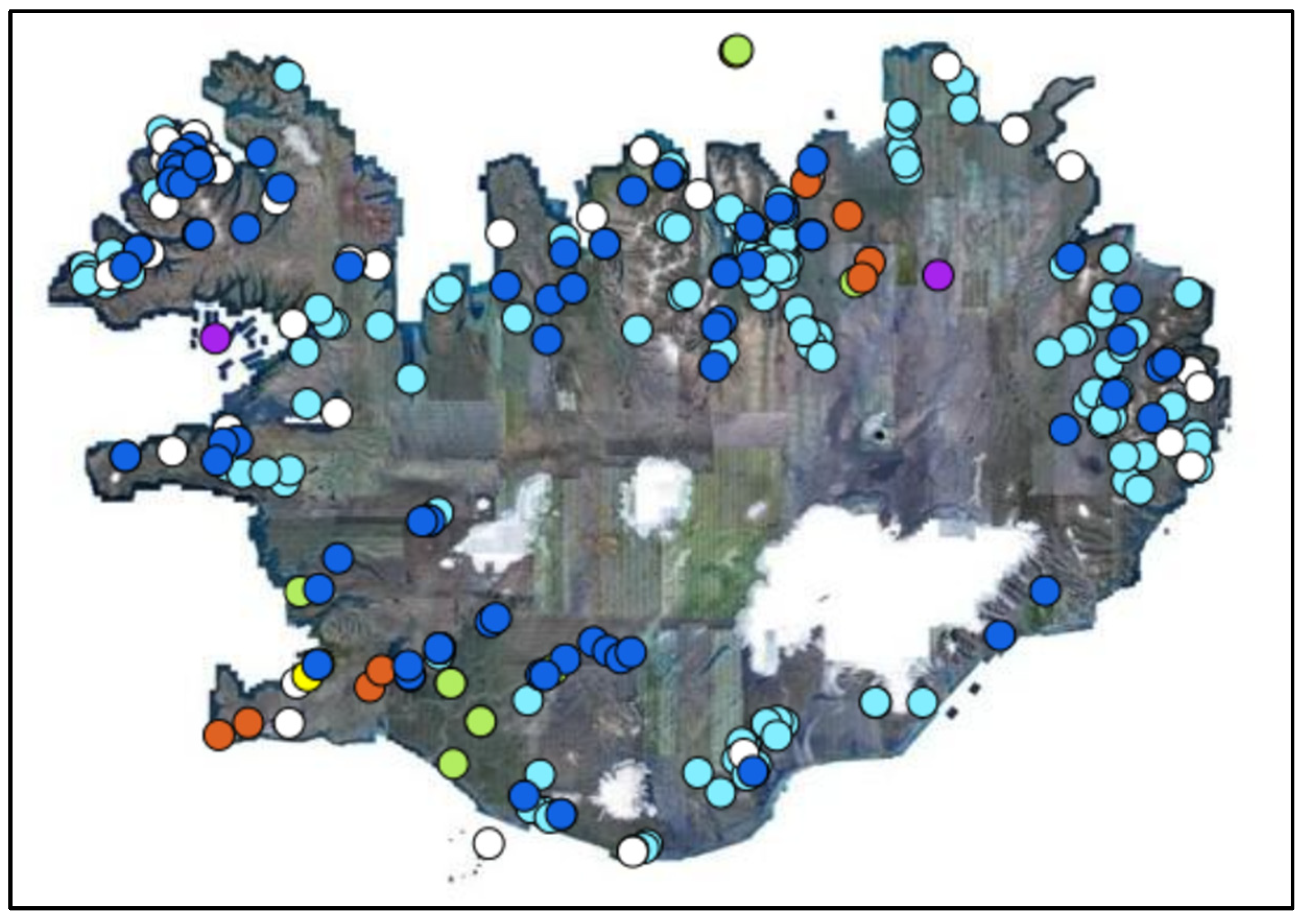
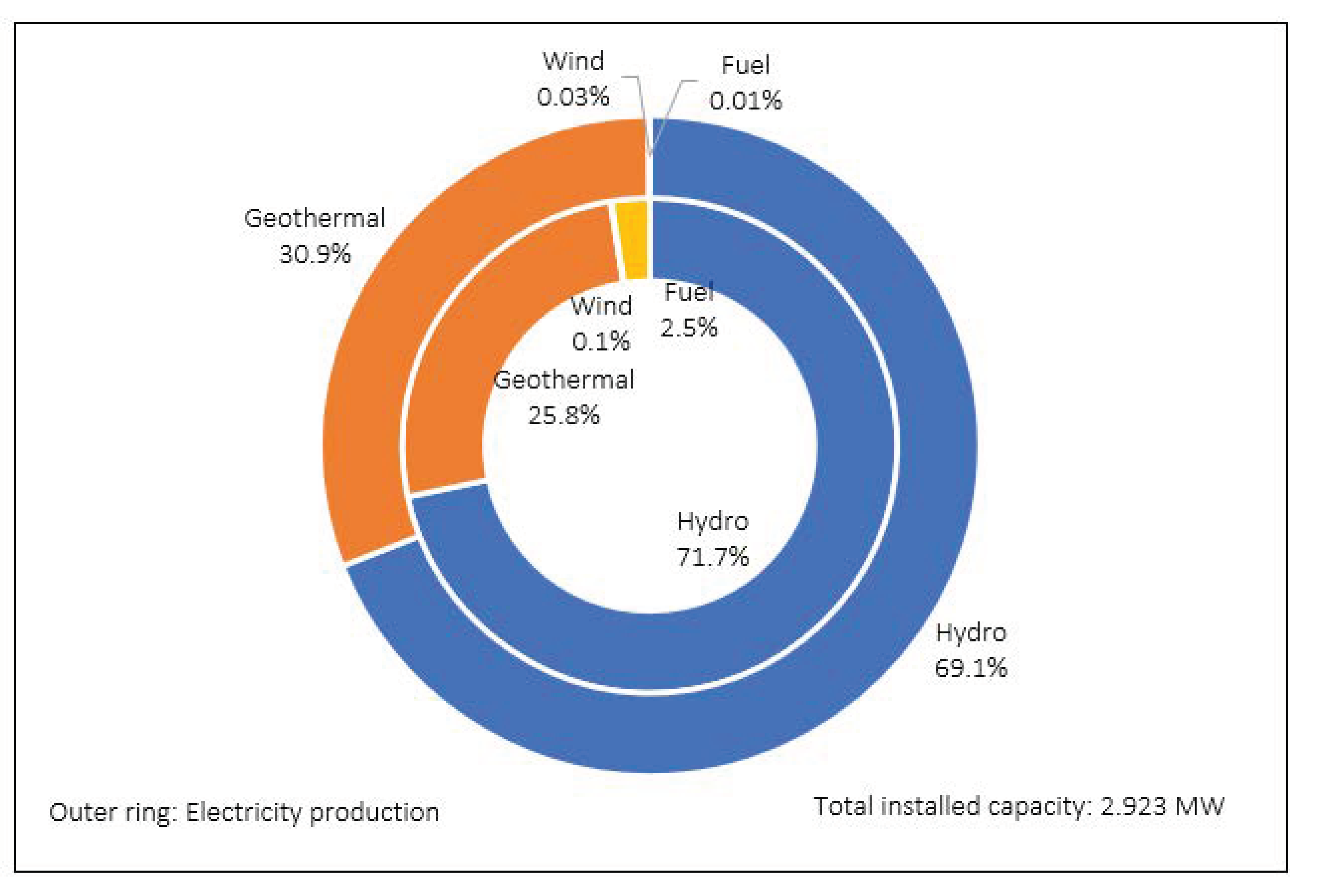
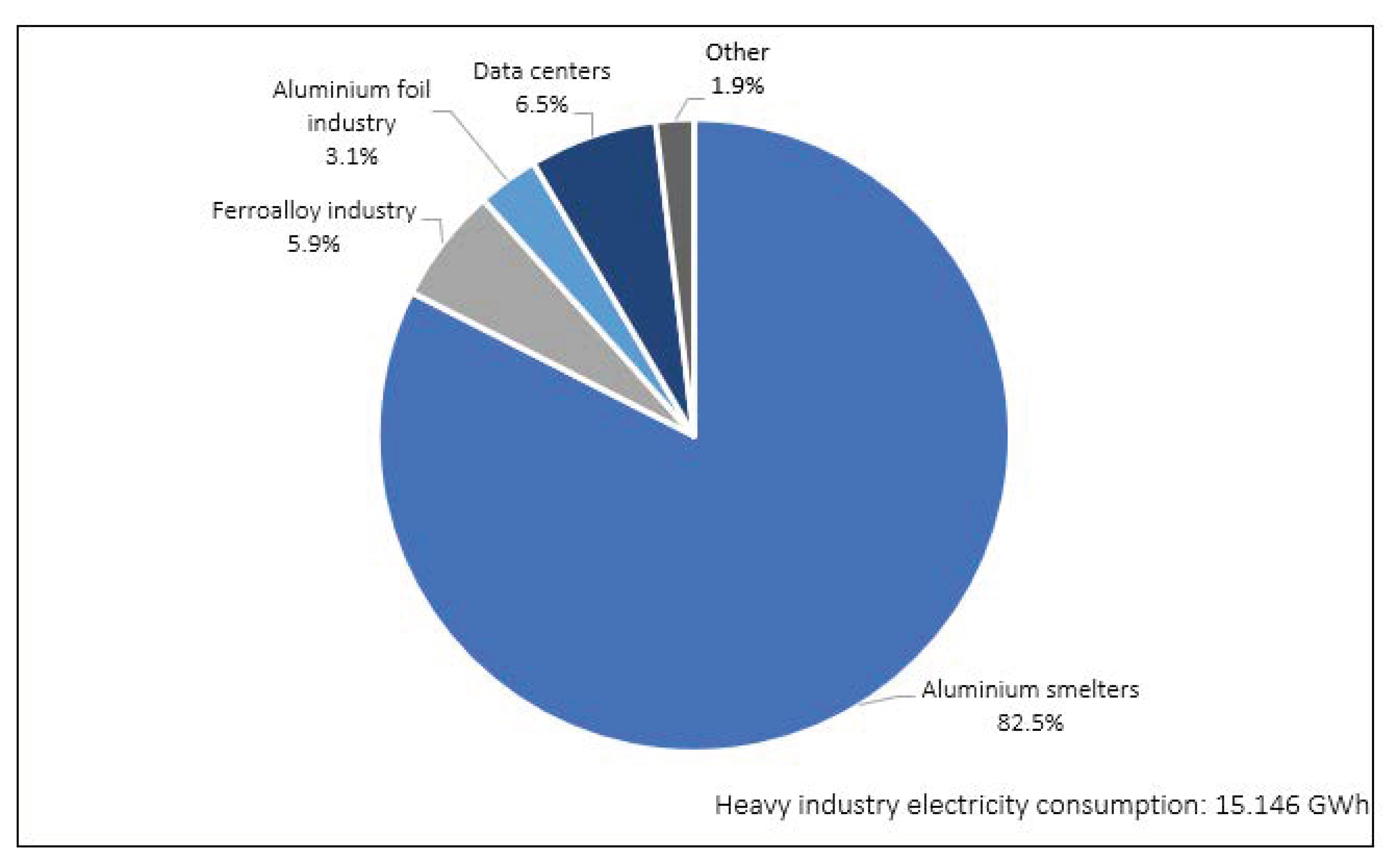
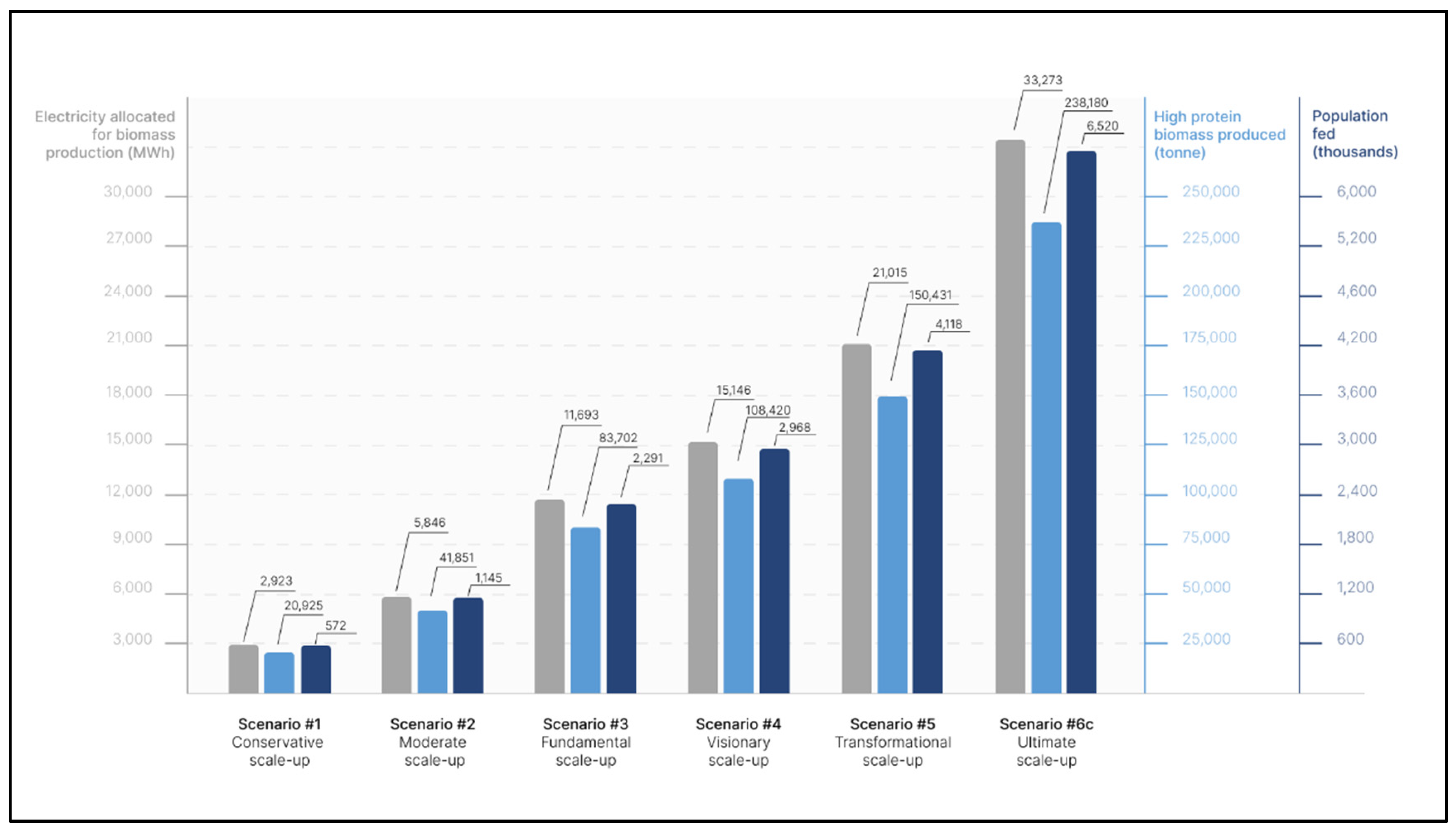
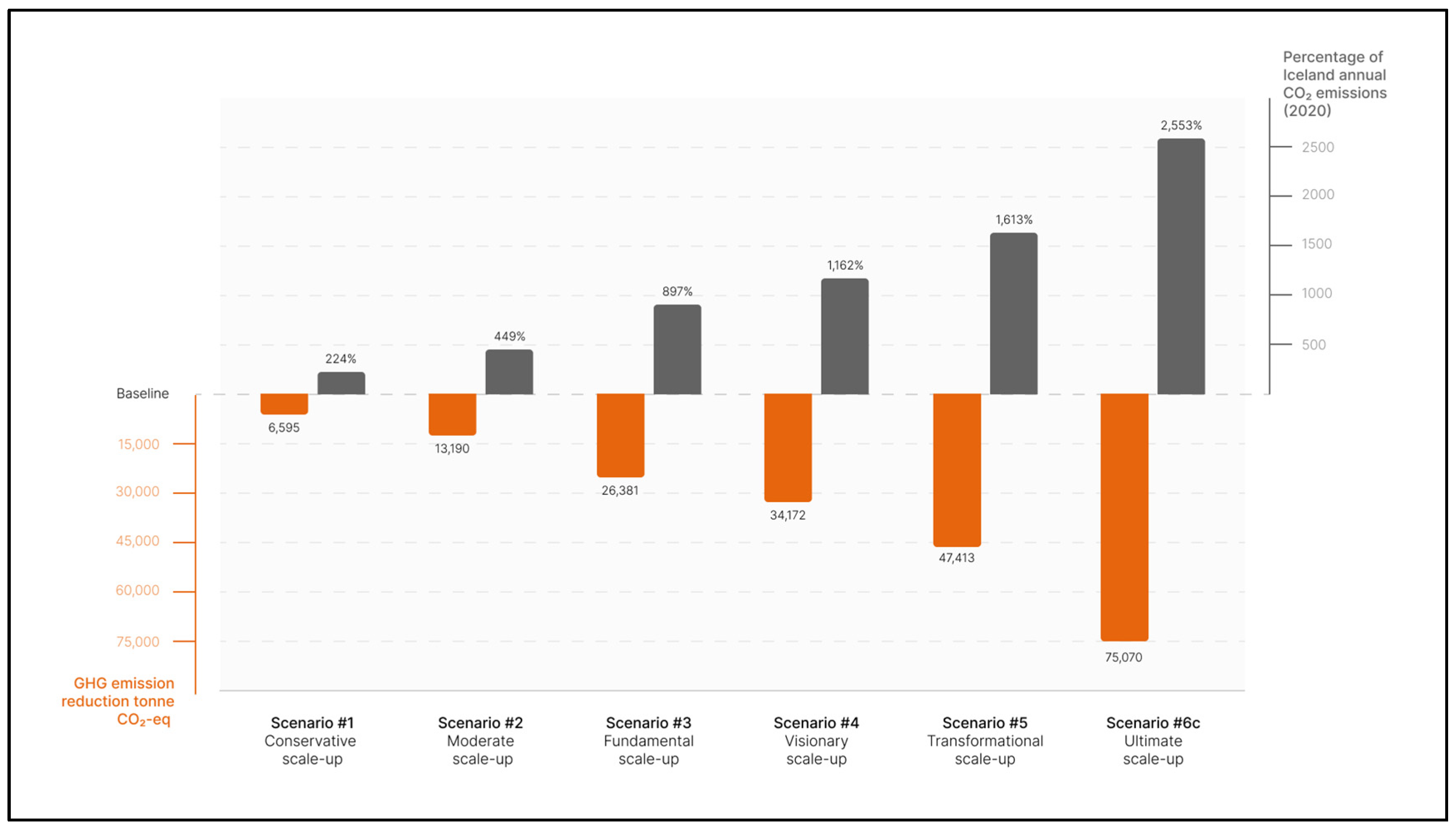
| Content | Value | Unit |
|---|---|---|
| Protein | 0.6495 | kg protein per kg DW Spirulina biomass |
| Threonine | 0.0307 | kg EEA per kg DW Spirulina biomass |
| Valine | 0.0335 | kg EEA per kg DW Spirulina biomass |
| Isoleucine | 0.0351 | kg EEA per kg DW Spirulina biomass |
| Leucine | 0.0538 | kg EEA per kg DW Spirulina biomass |
| Phenylalanine | 0.0293 | kg EEA per kg DW Spirulina biomass |
| Lysine | 0.0279 | kg EEA per kg DW Spirulina biomass |
| Histidine | 0.0100 | kg EEA per kg DW Spirulina biomass |
| Methionine | 0.0141 | kg EEA per kg DW Spirulina biomass |
| Tryptophan | 0.0097 | kg EEA per kg DW Spirulina biomass |
| Food Source | Protein Content | Unit |
|---|---|---|
| Spirulina (Hellisheidi PU) | 0.649 | g protein per g product |
| Meat, beef | 0.205 | g protein per g product |
| Meat, lamb | 0.196 | g protein per g product |
| Meat, pig | 0.212 | g protein per g product |
| Meat, poultry | 0.215 | g protein per g product |
| Eggs | 0.123 | g protein per g product |
| Milk | 0.034 | g protein per g product |
| Men (Avg. BW 70 kg) | Amount | Unit |
| Spirulina to meet protein requirement | 39.33 | kg DW Spirulina biomass per year |
| Spirulina to meet threonine requirement | 12.46 | kg DW Spirulina biomass per year |
| Spirulina to meet valine requirement | 19.80 | kg DW Spirulina biomass per year |
| Spirulina to meet isoleucine requirement | 14.55 | kg DW Spirulina biomass per year |
| Spirulina to meet leucine requirement | 18.50 | kg DW Spirulina biomass per year |
| Spirulina to meet phenylalanine requirement | 21.76 | kg DW Spirulina biomass per year |
| Spirulina to meet lysine requirement | 27.47 | kg DW Spirulina biomass per year |
| Spirulina to meet histidine requirement | 25.32 | kg DW Spirulina biomass per year |
| Spirulina to meet methionine requirement | 18.12 | kg DW Spirulina biomass per year |
| Spirulina to meet tryptophan requirement | 10.53 | kg DW Spirulina biomass per year |
| Women (avg. BW 60 kg) | Amount | Unit |
| Spirulina to meet protein requirement | 33.71 | kg DW Spirulina biomass per year |
| Spirulina to meet threonine requirement | 10.68 | kg DW Spirulina biomass per year |
| Spirulina to meet valine requirement | 16.97 | kg DW Spirulina biomass per year |
| Spirulina to meet isoleucine requirement | 12.47 | kg DW Spirulina biomass per year |
| Spirulina to meet leucine requirement | 15.86 | kg DW Spirulina biomass per year |
| Spirulina to meet phenylalanine requirement | 18.65 | kg DW Spirulina biomass per year |
| Spirulina to meet lysine requirement | 23.54 | kg DW Spirulina biomass per year |
| Spirulina to meet histidine requirement | 21.70 | kg DW Spirulina biomass per year |
| Spirulina to meet methionine requirement | 15.53 | kg DW Spirulina biomass per year |
| Spirulina to meet tryptophan requirement | 9.03 | kg DW Spirulina biomass per year |
| Country | Population Projections (2030) |
|---|---|
| United Kingdom | 69,175,770 |
| Sweden | 11,007,228 |
| Denmark | 6,104,474 |
| Finland | 5,565,475 |
| Norway | 5,748,397 |
| Ireland | 5,266,881 |
| Lithuania | 2,558,929 |
| Latvia | 1,701,338 |
| Estonia | 1,289,441 |
| Iceland | 390,338 |
| Jersey | 119,047 |
| Isle of Man | 85,798 |
| Guernsey | 65,141 |
| Faroe Islands | 54,583 |
Disclaimer/Publisher’s Note: The statements, opinions and data contained in all publications are solely those of the individual author(s) and contributor(s) and not of MDPI and/or the editor(s). MDPI and/or the editor(s) disclaim responsibility for any injury to people or property resulting from any ideas, methods, instructions or products referred to in the content. |
© 2022 by the authors. Licensee MDPI, Basel, Switzerland. This article is an open access article distributed under the terms and conditions of the Creative Commons Attribution (CC BY) license (https://creativecommons.org/licenses/by/4.0/).
Share and Cite
Tzachor, A.; Richards, C.E.; Smidt-Jensen, A.; Skúlason, A.Þ.; Ramel, A.; Geirsdóttir, M. The Potential Role of Iceland in Northern Europe’s Protein Self-Sufficiency: Feasibility Study of Large-Scale Production of Spirulina in a Novel Energy-Food System. Foods 2023, 12, 38. https://doi.org/10.3390/foods12010038
Tzachor A, Richards CE, Smidt-Jensen A, Skúlason AÞ, Ramel A, Geirsdóttir M. The Potential Role of Iceland in Northern Europe’s Protein Self-Sufficiency: Feasibility Study of Large-Scale Production of Spirulina in a Novel Energy-Food System. Foods. 2023; 12(1):38. https://doi.org/10.3390/foods12010038
Chicago/Turabian StyleTzachor, Asaf, Catherine E. Richards, Asger Smidt-Jensen, Arnar Þór Skúlason, Alfons Ramel, and Margrét Geirsdóttir. 2023. "The Potential Role of Iceland in Northern Europe’s Protein Self-Sufficiency: Feasibility Study of Large-Scale Production of Spirulina in a Novel Energy-Food System" Foods 12, no. 1: 38. https://doi.org/10.3390/foods12010038
APA StyleTzachor, A., Richards, C. E., Smidt-Jensen, A., Skúlason, A. Þ., Ramel, A., & Geirsdóttir, M. (2023). The Potential Role of Iceland in Northern Europe’s Protein Self-Sufficiency: Feasibility Study of Large-Scale Production of Spirulina in a Novel Energy-Food System. Foods, 12(1), 38. https://doi.org/10.3390/foods12010038






